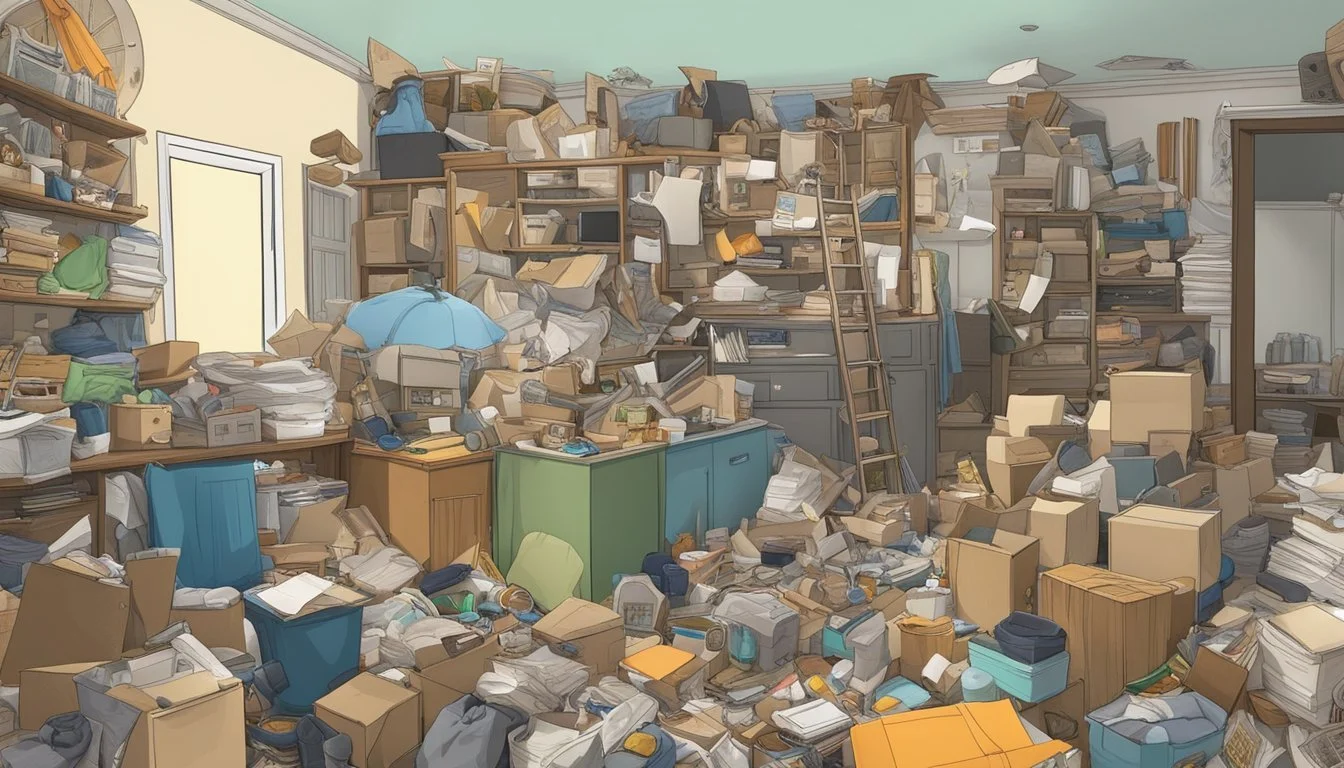Inside a Hoarding Disorder House: Understanding the Risks and Challenges
Hoarding disorder affects an estimated 2-5% of the population, causing individuals to accumulate excessive amounts of possessions in their homes. These cluttered living spaces, known as hoarder houses, can pose serious health and safety risks to both occupants and their communities. Hoarding disorder is characterized by persistent difficulty discarding or parting with possessions, regardless of their actual value, leading to severely cluttered and often hazardous living conditions.
People with hoarding disorder experience extreme distress at the thought of getting rid of items, even those that may seem worthless to others. This compulsive behavior can result in homes filled with stacks of newspapers, broken appliances, old clothing, and countless other objects. The accumulation of items can become so severe that it interferes with daily activities, such as cooking, cleaning, or even moving freely within the home.
Hoarder houses often present significant challenges for the individuals living in them, as well as for their families and neighbors. The excessive clutter can create fire hazards, contribute to unsanitary conditions, and even cause structural damage to the building. Addressing hoarding disorder requires a compassionate and multi-faceted approach, involving mental health professionals, organizers, and sometimes local authorities to ensure the safety and well-being of those affected.
Understanding Hoarding Disorder
Hoarding disorder is a complex mental health condition characterized by excessive accumulation of items and difficulty discarding possessions. It can severely impact a person's living space, relationships, and daily functioning.
Definition and Diagnostic Criteria
Hoarding disorder involves persistent difficulty parting with possessions, regardless of their actual value. Individuals experience intense distress at the thought of discarding items. The Diagnostic and Statistical Manual of Mental Disorders (DSM-5) outlines specific criteria for diagnosis:
Persistent difficulty discarding possessions
Perceived need to save items
Accumulation of items that congest living areas
Significant distress or impairment in daily functioning
The clutter must not be attributable to another medical condition or mental disorder. Hoarding behavior often leads to unsafe or unsanitary living conditions.
Prevalence and Demographics
Hoarding disorder affects an estimated 2-6% of the population. It typically begins in adolescence or early adulthood but often goes unrecognized until later in life.
The condition affects people across various demographics:
Gender: Roughly equal prevalence in males and females
Age: More common in older adults, but can occur at any age
Socioeconomic status: Affects individuals across all income levels
Hoarding tendencies often worsen with age. Many individuals with hoarding disorder also experience co-occurring mental health conditions such as depression, anxiety, or obsessive-compulsive disorder.
Characteristics of a Hoarding Disorder House
Homes affected by hoarding disorder exhibit distinct features that impact living conditions and safety. These characteristics often make the space difficult to navigate and maintain.
Clutter and Organization Issues
Excessive accumulation of items is the hallmark of a hoarding disorder house. Every available surface, including floors, countertops, and furniture, becomes covered with possessions. Stacks of newspapers, magazines, and books often reach ceiling height.
Clothes, trinkets, and miscellaneous objects pile up in rooms, creating narrow pathways through the clutter. Kitchen appliances and bathroom fixtures may be rendered unusable due to the overwhelming amount of items.
Storage spaces like closets, attics, and garages become packed to capacity. This leaves no room for proper organization or storage of essential items. The sheer volume of possessions makes it challenging to clean or maintain the living space effectively.
Safety Concerns and Health Risks
The excessive clutter in a hoarding disorder house poses significant safety hazards. Fire risks increase due to blocked exits and flammable materials piled near heat sources. The weight of accumulated items can strain floor joists, potentially compromising structural integrity.
Poor air quality is common, as dust, mold, and mildew thrive in cluttered environments. This can exacerbate respiratory issues and allergies. Pest infestations often occur, attracted by food waste and hiding places within the clutter.
Tripping hazards abound, increasing the risk of falls and injuries. Sanitation becomes a major concern, as clutter makes it difficult to clean properly. This can lead to the spread of bacteria and pathogens, further compromising health and well-being.
Causes and Contributing Factors
Hoarding disorder stems from a complex interplay of psychological, environmental, and biological factors. Research has identified several key contributors that may influence the development and progression of this condition.
Psychological Perspectives
Cognitive-behavioral models suggest that hoarding behaviors often arise from distorted beliefs about possessions. Individuals with hoarding disorder may attach excessive emotional significance to objects, viewing them as extensions of their identity or security. This can lead to intense anxiety when faced with discarding items.
Perfectionism and indecisiveness also play roles. The fear of making wrong decisions about what to keep or discard can paralyze a person, resulting in accumulation. Trauma or loss may contribute, as some use hoarding as a coping mechanism.
Underlying mental health conditions like depression, anxiety, or obsessive-compulsive disorder frequently co-occur with hoarding. These issues can exacerbate hoarding tendencies and complicate treatment efforts.
Environmental Influences
Childhood experiences significantly impact hoarding behaviors. Growing up in a cluttered home or with family members who hoarded can normalize excessive accumulation. Conversely, experiencing material deprivation may lead to overcompensation through hoarding in adulthood.
Stressful life events often trigger or worsen hoarding. Major changes like divorce, job loss, or the death of a loved one can intensify the need for control and comfort through acquiring possessions.
Social isolation can reinforce hoarding tendencies. As clutter increases, individuals may withdraw from social interactions, creating a cycle that further enables the behavior.
Cultural factors also play a role. Consumerist societies that emphasize material possessions may inadvertently contribute to hoarding tendencies in vulnerable individuals.
Genetic and Biological Factors
Research indicates a genetic component to hoarding disorder. Studies of twins and families show higher rates of hoarding behaviors among first-degree relatives of those with the condition. This suggests a hereditary predisposition, though having a genetic risk doesn't guarantee development of the disorder.
Brain imaging studies have revealed differences in neural activity and structure in individuals with hoarding disorder. Areas involved in decision-making, attachment, and emotional regulation show altered functioning. These neurobiological differences may contribute to difficulty in discarding items and emotional attachments to possessions.
Certain neurotransmitter imbalances, particularly in the serotonin system, have been linked to hoarding behaviors. This connection provides insight into why some medications used for related disorders may also help in treating hoarding.
Challenges and Complications
Hoarding disorder creates significant obstacles in daily life and relationships. The excessive accumulation of items leads to practical difficulties and emotional distress for those affected and their loved ones.
Impact on Daily Living
Hoarding severely restricts the use of living spaces. Rooms become filled with stacks of possessions, making normal activities challenging or impossible. Kitchen counters and tables may be unusable for food preparation. Bathrooms can become inaccessible or unsanitary.
Clutter creates fire hazards and blocks emergency exits. Piles of items increase the risk of falls and injuries. Accumulated dust, mold, and pests pose health risks.
Basic home maintenance becomes difficult. Repairs go undone as workers can't access problem areas. Utility shut-offs may occur if meters are unreachable.
Social and Emotional Consequences
Hoarding often strains relationships with family and friends. Loved ones may feel frustrated or angry about the clutter. Social isolation increases as people avoid inviting others to their homes.
Shame and embarrassment about living conditions are common. This can lead to withdrawal from social activities and connections.
Depression frequently co-occurs with hoarding disorder. The overwhelming nature of the clutter can fuel feelings of hopelessness. Anxiety may increase due to fears about losing possessions or having others see the home.
Conflict with neighbors or landlords may arise over health and safety concerns. Legal issues like eviction are possible in severe cases.
Assessment Strategies
Effective evaluation of hoarding disorder requires specialized tools and techniques. Professional assessments and risk evaluations help determine the severity and impact of hoarding behaviors.
Professional Evaluation Methods
Clinicians use structured interviews and standardized rating scales to diagnose hoarding disorder. The Saving Inventory-Revised (SIR) is a 23-item questionnaire that measures excessive acquisition, difficulty discarding, and clutter. It helps quantify hoarding symptoms and track progress over time.
The Clutter Image Rating (CIR) uses a series of photographs to visually assess clutter levels in different rooms. Patients select images that best represent their living spaces, providing an objective measure of clutter severity.
Mental health professionals may also conduct home visits to directly observe living conditions and safety hazards. This allows for a comprehensive evaluation of the hoarding behaviors and their impact on daily functioning.
Risk Assessment
The HOMES Multi-disciplinary Hoarding Risk Assessment is a tool used to evaluate potential hazards in hoarding situations. It examines factors like fire risk, fall hazards, unsanitary conditions, and structural damage.
Professionals assess health and safety risks, including:
Blocked exits and pathways
Unstable piles of items
Presence of pests or mold
Inadequate sanitation
Fire departments and code enforcement officials may be involved in risk evaluations. They can identify violations and imminent dangers requiring immediate intervention.
Assessing the person's insight into their hoarding behaviors is crucial. This helps determine appropriate treatment approaches and the level of support needed.
Intervention and Treatment Options
Effective interventions for hoarding disorder combine therapeutic approaches and medical management. These strategies aim to address both the psychological and behavioral aspects of the condition.
Therapeutic Approaches
Cognitive Behavioral Therapy (CBT) is the primary treatment for hoarding disorder. It helps individuals identify and change thought patterns and behaviors related to acquiring and discarding items. CBT sessions often involve exposure exercises, where patients practice sorting and discarding objects.
Support groups provide a space for individuals to share experiences and coping strategies. These groups can reduce feelings of isolation and offer practical tips for managing clutter.
Professional organizers specializing in hoarding cases can assist in developing sorting systems and decluttering strategies. They work alongside therapists to implement practical solutions in the home environment.
Medications and Medical Management
Selective Serotonin Reuptake Inhibitors (SSRIs) may be prescribed to manage symptoms of anxiety and depression often associated with hoarding disorder. These medications can help reduce the emotional distress linked to discarding items.
Regular medical check-ups are crucial to monitor physical health issues that may arise from living in cluttered environments. Doctors can address respiratory problems, fall risks, and other health concerns related to hoarding.
Occupational therapy can be beneficial in improving daily living skills and creating safer home environments. Therapists work on enhancing organization abilities and developing routines to maintain a clutter-free space.
Support and Resources
Individuals struggling with hoarding disorder can access various forms of assistance. Professional help and community support play crucial roles in managing this condition effectively.
Family and Community Support
Family members and friends can provide valuable emotional support to those with hoarding disorder. They can offer encouragement, patience, and understanding throughout the recovery process. Local support groups bring together individuals facing similar challenges, creating a sense of community and shared experience.
Online forums and virtual support groups enable people to connect and share strategies from the comfort of their homes. These platforms often include professionals who can offer guidance and answer questions. Some communities organize volunteer clean-up efforts to assist hoarders in decluttering their living spaces.
Organizational and Cleaning Services
Professional organizers specializing in hoarding situations can help create personalized decluttering plans. These experts understand the emotional attachments hoarders have to their possessions and approach the process with sensitivity.
Cleaning services trained in handling hoarding cases can tackle severe clutter and unsanitary conditions. They work alongside mental health professionals to ensure the cleanup process aligns with the individual's treatment plan.
Some organizations offer free or low-cost cleaning assistance for low-income individuals struggling with hoarding. Local government agencies may provide resources or referrals to appropriate services in severe cases that pose health or safety risks.
Legal and Ethical Considerations
Hoarding disorder cases present complex legal and ethical challenges. Property owners and authorities must balance individual rights with public safety concerns.
Eviction processes involving hoarding often require special considerations. Landlords may need to provide reasonable accommodations under fair housing laws if hoarding is related to a disability.
Courts are increasingly recognizing hoarding as a mental health condition. This awareness can impact how cases are handled, potentially leading to interventions rather than immediate eviction.
Collaboration between legal, mental health, and social services professionals is often necessary. This multidisciplinary approach helps address both the legal and personal aspects of hoarding situations.
Ethical considerations include respecting the individual's autonomy while mitigating risks to health and safety. Interventions should aim to support the person with hoarding disorder rather than simply removing possessions.
Legal issues may arise from building code violations, fire hazards, or health concerns. Local authorities may become involved if conditions pose risks to the community.
Privacy rights must be balanced with the need for intervention. Professionals should obtain proper consent or legal authority before entering or altering a person's living space.
Mandatory reporting laws may apply if vulnerable individuals are at risk due to hoarding conditions. Health care providers and social workers should be aware of their legal obligations in such situations.
Long-term Management and Prevention
Effective long-term management of hoarding disorder requires ongoing effort and support. A structured maintenance plan is crucial for individuals to sustain progress and prevent relapse.
Regular decluttering sessions help maintain organized living spaces. Setting aside time each week to sort through items and make decisions about what to keep or discard can prevent accumulation.
Professional support remains valuable even after initial treatment. Periodic check-ins with a therapist or counselor can reinforce coping strategies and address emerging challenges.
Developing a support network is essential. Family members, friends, or support groups can provide encouragement and accountability.
Stress management techniques play a key role in preventing hoarding behaviors. Practices like mindfulness, meditation, or exercise can help individuals cope with anxiety or urges to acquire items.
Creating a system for organizing and categorizing possessions helps maintain order. This might include designated storage areas or labeling systems.
Setting clear goals and boundaries around acquiring new items is important. Individuals can establish rules for themselves, such as a "one in, one out" policy for belongings.
Regular self-assessment allows individuals to monitor their progress and identify potential warning signs. Keeping a journal or using a tracking app can be helpful tools.









